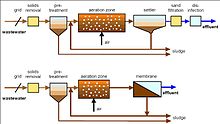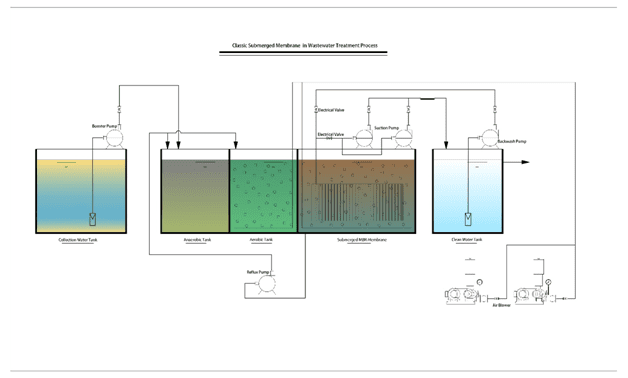Membrane Layer Bioreactors Explained: Effective Solutions for Tidy Water
Membrane bioreactors (MBRs) have arised as an innovative solution for dealing with journalism obstacles of wastewater therapy. By integrating biological processes with sophisticated membrane layer filtering, MBRs not just boost the top quality of treated water but likewise decrease the spatial demands of therapy centers. As ecological worries intensify, the role of MBR innovation in promoting sustainable water monitoring becomes increasingly significant. The complexities of their operation, benefits, and possible applications merit a closer exam to fully recognize their effect on the future of water treatment.
What Are Membrane Layer Bioreactors?
Membrane bioreactors (MBRs) are advanced wastewater therapy systems that incorporate organic destruction procedures with membrane filtration modern technology. This integration permits for the efficient removal of contaminants from water, making MBRs a preferred selection in different applications, including municipal wastewater therapy and industrial effluent management.

One of the critical advantages of MBRs is their ability to generate high-quality effluent, usually appropriate for reuse in irrigation or commercial procedures. In addition, MBRs require a smaller sized footprint compared to standard therapy systems, making them excellent for urban settings where space might be limited.
Furthermore, MBRs can properly handle varying influent lots and are less prone to the effects of hazardous shocks. These characteristics add to their expanding appeal as a lasting solution for addressing the boosting need for tidy water while minimizing environmental effects.
Exactly How Membrane Layer Bioreactors Job
While the operation of membrane bioreactors (MBRs) might seem complicated, it basically revolves around the synergy in between biological processes and membrane filtering. MBRs integrate an organic therapy procedure, commonly triggered sludge, with a membrane layer splitting up unit to deal with wastewater effectively.
In an MBR system, wastewater is initial presented right into a bioreactor where microbes deteriorate natural issue and various other impurities. The biological activity decreases the concentration of contaminants while promoting the growth of biomass. Following this biological treatment, the mixed liquor is subjected to membrane filtration, which can be microfiltration or ultrafiltration, depending on the wanted effluent high quality.
The membranes serve as a physical barrier, permitting water and small solutes to pass while retaining suspended solids and bigger molecules. This makes it possible for the system to keep a high focus of biomass within the activator, improving the treatment effectiveness.
Furthermore, the continuous separation of cured water from the biomass assists in a small style and reduces the impact of the therapy center. Generally, the combination of organic destruction and membrane layer filtering in MBRs results in reliable and reliable wastewater treatment, making sure top quality effluent suitable for numerous applications.
Benefits of MBR Technology
One of the essential advantages of membrane bioreactor (MBR) innovation is its ability to generate high-quality effluent with a considerably minimized footprint compared to standard wastewater treatment techniques. MBR systems effectively incorporate biological therapy and membrane layer purification, leading to premium elimination of impurities, including put on hold solids, microorganisms, and raw material. This capacity results in effluent that often meets or exceeds rigorous governing requirements for reuse and discharge.
Additionally, MBR modern technology enables greater biomass concentrations, which boosts the treatment effectiveness and decreases the called for reactor volume. This compact style is especially useful in city areas where area is restricted. The operational versatility of MBR systems additionally means they can adapt to differing influent top qualities and flow rates, making them appropriate for a large range of applications.
Additionally, the reduced sludge production connected with MBR procedures adds to lower operational and maintenance expenses. The membrane layers act as a physical barrier, reducing the danger of obstructing and making it possible for longer operational periods between cleaning. In general, the advantages of MBR hop over to these guys innovation make it an eye-catching remedy for lasting wastewater therapy, addressing both environmental concerns and the need for efficient resource management.
Applications of Membrane Bioreactors
With their versatility and efficiency, membrane bioreactors (MBRs) find applications across numerous fields, consisting of municipal wastewater therapy, commercial procedures, and even water improvement. In community settings, MBRs provide a compact solution for dealing with wastewater, properly getting rid of pollutants while all at once generating top notch effluent that meets strict governing standards. This makes them particularly suitable for areas with minimal area.
In commercial applications, MBR innovation is used for treating procedure water, specifically in markets such as food and beverage, drugs, and petrochemicals. These markets gain from MBRs' capacity to manage high organic loads and their performance in recuperating important sources from wastewater, such as nutrients and water.
In try this site addition, MBRs play a critical function in water reclamation campaigns, allowing the reuse of dealt with wastewater for irrigation, commercial processes, or perhaps as drinkable water after further therapy (Membrane Bioreactor). Their efficiency in getting rid of contaminants and pathogens makes them a dependable choice for making sure water quality in numerous reuse applications
Future of Water Treatment Solutions
The future of water therapy solutions is positioned for transformative why not try this out advancements driven by technological technology and enhancing ecological awareness. As worldwide water deficiency ends up being a pushing issue, new methodologies, including membrane layer bioreactor (MBR) systems, are established to play a critical function in enhancing the effectiveness and sustainability of water therapy procedures.
Arising modern technologies such as man-made intelligence and artificial intelligence are expected to optimize therapy procedures, permitting real-time monitoring and predictive maintenance. This will boost the total reliability and efficiency of water therapy centers. Improvements in membrane layer products, such as graphene and nanofiltration, guarantee to boost permeation prices and minimize fouling, leading to reduced power usage and operational expenses.
Additionally, the integration of renewable resource resources into water treatment plants will certainly add to greener methods. The circular economic situation version will also gain grip, motivating the recovery of beneficial sources from wastewater, such as nutrients and energy.
Conclusion

Membrane bioreactors (MBRs) have actually emerged as an innovative option for resolving the pushing challenges of wastewater therapy. By integrating biological procedures with advanced membrane layer filtration, MBRs not just boost the high quality of cured water however additionally decrease the spatial needs of treatment centers.One of the essential benefits of membrane layer bioreactor (MBR) technology is its capacity to produce high-grade effluent with a substantially reduced impact contrasted to standard wastewater treatment techniques.With their convenience and performance, membrane bioreactors (MBRs) discover applications throughout various industries, including metropolitan wastewater therapy, industrial processes, and even water improvement.In verdict, membrane bioreactors represent a considerable innovation in wastewater treatment technology, integrating organic processes with reliable membrane purification to produce high-quality effluent.